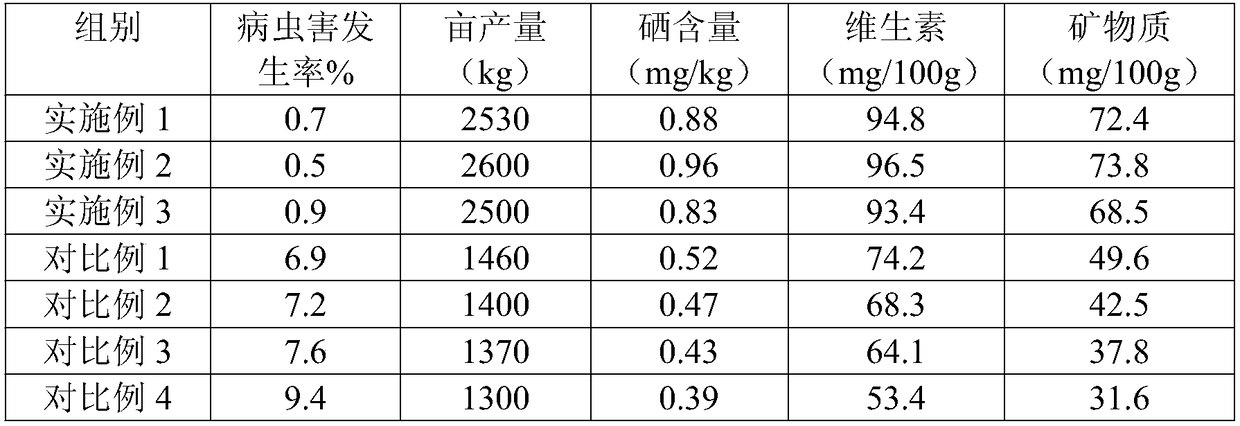Method for planting selenium-rich oranges
A planting method and selenium-enriched technology, applied in the direction of fertilizers made from biological waste, applications, organic fertilizers, etc., can solve the problems of water retention, fertilizer retention, poor air permeability, damage to soil physical structure, and low quality oranges, and achieve significant sterilization Insecticidal effect, promoting plant growth, enhancing biological activity
- Summary
- Abstract
- Description
- Claims
- Application Information
AI Technical Summary
Problems solved by technology
Method used
Image
Examples
Embodiment 1
[0033] A planting method of selenium-enriched orange, comprising the following steps:
[0034] (1) Put the garden weeds and topsoil into the bottom of the planting ditch, every 667m 2 Sprinkle 700-725kg of lime powder, and use 1000-2000kg of base fertilizer, 200-300kg of magnesium-containing soil conditioner and subsoil to backfill the planting ditch, raising the height to 25-30cm;
[0035] (2) 20 days before planting, use a mixture of 75% soil and 25% organic fertilizer to make a small mound 28-35 cm higher than the border surface on the planting border. At the beginning of January, put the fruit seedlings into the soil after being covered with mud. When covering the soil, the seedling grafting interface is 0.5-1cm higher than the mound surface, and the soil humidity is kept at 70-90%;
[0036] (3) Keep the soil humidity at 60-78% in the seedling stage. From the beginning of March to the end of September, apply fertilizer to the seedlings every 15-20 days on sunny days. The ...
Embodiment 2
[0050] A method for planting selenium-enriched oranges, the base fertilizer is composed of the following raw materials in parts by weight: 37 parts of coconut shells, 15 parts of chestnut shells, 37.5 parts of cow dung, 22.5 parts of chicken manure, 25 parts of bagasse, and 17.5 parts of corn dregs , 25 parts of diatomite, 9 parts of medical stone, 11 parts of distiller's grains, 5 parts of pomegranate bark, 4 parts of sheepshoe bark, 21 parts of ryegrass, 15 parts of milk vetch, 20 parts of alfalfa, chlorothalonil 0.08 parts, azoxystrobin 0.25 parts, calcium molybdate 0.0065 parts, sodium selenate 0.125 parts.
[0051] A method for planting selenium-enriched oranges, wherein the organic fertilizer is composed of the following raw materials in parts by weight: 9 parts of ferrous selenate, 1.5 parts of sodium selenite, 15 parts of potassium chloride, 31 parts of potassium dihydrogen phosphate, zinc sulfate 6.5 parts, 1.5 parts of manganese sulfate, 5.5 parts of magnesium sulfat...
Embodiment 3
[0055] A method for planting selenium-enriched oranges, wherein the base fertilizer is composed of the following raw materials in parts by weight: 38 parts of coconut shells, 16 parts of chestnut shells, 40 parts of cow dung, 25 parts of chicken manure, 26 parts of bagasse, and 20 parts of corn dregs , 30 parts of diatomite, 10 parts of medical stone, 12 parts of distiller's grains, 6 parts of pomegranate bark, 5 parts of sheepshoe bark, 24 parts of ryegrass, 20 parts of milk vetch, 25 parts of alfalfa, chlorothalonil 0.09 parts, azoxystrobin 0.3 parts, calcium molybdate 0.008 parts, sodium selenate 0.15 parts.
[0056] A method for planting selenium-enriched oranges, wherein the organic fertilizer is composed of the following raw materials in parts by weight: 12 parts of ferrous selenate, 2 parts of sodium selenite, 18 parts of potassium chloride, 40 parts of potassium dihydrogen phosphate, zinc sulfate 7 parts, 2 parts of manganese sulfate, 6 parts of magnesium sulfate, 5 pa...
PUM
 Login to View More
Login to View More Abstract
Description
Claims
Application Information
 Login to View More
Login to View More - R&D
- Intellectual Property
- Life Sciences
- Materials
- Tech Scout
- Unparalleled Data Quality
- Higher Quality Content
- 60% Fewer Hallucinations
Browse by: Latest US Patents, China's latest patents, Technical Efficacy Thesaurus, Application Domain, Technology Topic, Popular Technical Reports.
© 2025 PatSnap. All rights reserved.Legal|Privacy policy|Modern Slavery Act Transparency Statement|Sitemap|About US| Contact US: help@patsnap.com

